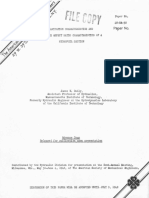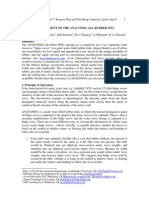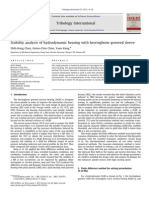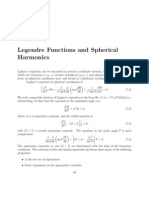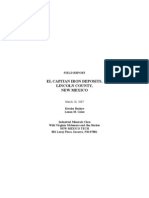Cavitation Along: Slain
Cavitation Along: Slain
Uploaded by
Mourad TargaouiCopyright:
Available Formats
Cavitation Along: Slain
Cavitation Along: Slain
Uploaded by
Mourad TargaouiOriginal Title
Copyright
Available Formats
Share this document
Did you find this document useful?
Is this content inappropriate?
Copyright:
Available Formats
Cavitation Along: Slain
Cavitation Along: Slain
Uploaded by
Mourad TargaouiCopyright:
Available Formats
"'!
_DTIC_-"
1P
%L WQ r'L
Im
60-WA-265
JUNf 2 2 19941 I
F
i
Cavitation Along Slain
of Separation
APR 17 1
C DAVID W. APPEL
G Professor of Hydraulics,
, Department of Engineering
Mechanics, The University This document has been apprcved
of Kansas, Lawrence, Kan. for public release a.d sale; its
distribution
is unli-ited.
By means of a moving picture accompanying
this presentation,
the
author demonstrates
the development
of cavitation
in flow along a
two-dimensional
surface of separation.
This film has been chosen as
the best means of presenting
some of the qualitative
characteristics
of
this type of cavitation
which are important
to engineers concerned
with
cavitation
in diverse practical
situations.
A description
of the experi-
ments, some views from the movie, and a discussion
of the observations
of cavitation
in a zone of separation
are given in the paper.
The majority
of enginccrs
coniccrned
with various aspects of cavi-
tation are especially
interested
in well-streamlined
flows such as in the
passages
of pumps and turbines,
through tunnels,
over spillways
and
around the propellers
of ships and submerged
bodies.
Therefore,
it is
natural and best that primary attention
has been given to cavitation
as-
sociated
with these various boundary
forms. In many studies the pres-
ence of separation
and the possibility
of cavitation
originating
along
surfaces
of separation
has been recognized.
However,
mot of the
studies reported
in the engineering
journals
have not been concerned
primarily
with this ocurrence.
On the other hand, there has been much
interest in the basic structure
of flow in a zone of separation
in the ab-
sence of cavitation,
with much of the work in this area being of a theo-
reticalnature.
The exploratory
study described
here was undertaken
in
an attempt
to bridge the gap between
these two areas of endeavor.
Ini-
tially qualitative
information
both on cavitation
and on the develop-
ment of vortices
and/or turbulence
along surfaces of separation
was
sought by direct photographic
observation.
Even the initial results were
found to be very revealing.
To make them immzdiately
available
to
other investigators
as well as to engineers
in practice,
the films have
been prepared
for presentation.
Contributed
by the Hydraulic
Division
tr presentation
at the Winer Annual Meet.
Ing. New Yolk, N. Y., November
t7.December
2. 1960, ol The American
Society
of
Mechanical
Engineers.
Manuscript
received at ASME Headquarters,
August 30, 1960.
Written discussion
on this paper will be accepted up to January 10, 1"1
Copies will be available until October I, 1961. -
0 06
r4!
f.7 '
QULT~
~ 7~
-
DTTC
.i.
.9-
T 61-
X ~
4 ra A D- p., L L ~B ER 60-WA-265
fffB 189 UIHIII 2U 22 199
V ~~Cavitation Along SfaCe
of Separation
A~PR t.
DAVID W. APPEL
Professor of Hydraulics,
Department of Engineering _________________
Mechanics, The University This docLunen* has bee prv~
ansa, lwrene, an. for Pubic' release and sale; its
distribution is Lmnhiited.
By means of a moving picture accompanying this presentation, thc
author demonstrates the development of cavitation in flow along a
two-dimensional surface of separation. This film has beer, chosen as
the best means of presenting some of the qualitative choracterisics of
this type of cavitation which are important to engineers concerned with
cavitation in diverse practical situations. A description of the experi-
ments, some views from the movie, and a discussion of the observations
of cavitation in a zone of eparation are given in the paper.
Ci'l iiajorit,- ot engineers coixcrnd w itli v.arious aspccts of cavi-
ration are especially interested in well-streamiliitcd flows such as ini the
)aS3ages Of puisIP3 and turbines, through tunnels, over spillways and
:iround the propellers of ships and submerged hodies. Therefore, it is
natural and best that primary attention has becn given to cavitation as-
cociated with these various boundary forms. In many studies the pres-
enrce of separation and the possibility of cavitation originating along
surfaces of separation has been recognized. Hlowever, most of the
-tudie5 reported in the engineering journals have not heen concerned
rsrimarilv with this ocurrence. Onl the other hand, there has been much
interest in the basic structure of flow in a zone of separation in the ab-
sence of cavitation, with much of the work in this area being of a theo-
retical nature. The exploratory study described here was undertaken in
an attempt to bridge the gap betw.een these two areas of endeavor. Ii[-
rially qualitative information both on cavitation anJ on the develop-
ment of vortices and/or turbulence along surfaces of separation w~as
sought by direct photographic observation. Even the initial results were
* . - .found to be very revealing. To make them immadiately available to
othier investigators as well as to engineers in practice, the filmns have
been prepared for presentationi.
Contributed by the Hydraulic Division tor presentation at1 the Winter AnhudI Meel-
ing, New York. N. Y., November 27-December 2, 1960, of The American Society of
Mechanical Engineers. Manuicript received at ASMdE Headqsurters, August 30, 2960
Writter, discussion an !his paper wilt be accepted up to January to, 1961.
S ~ ~ ~Copies witl be available until October 2. 2962. -
- 7Y
- t - i~MIT
f
Fig. 1 Water tunnel used in experiment
EXPLORATORY EXPERIMENT In Figs . and 4 enlargements of individual
frames of the film are reproduced, the first
An existing small recirculating water tunnel showing the first 9 in. of the flow starting at
in the Fluid Mechanics Laboratory of the Univer- the abrupt expansion (visible in the upper left-
sity of Kansas was adapted for a first close look hand corner of the picture) and the second ex-
at flow along a surface of separation. The main tending from 3 to 12 in. from the expansion.
ducts of the tunnel, Fig.l, are 10 in. diam with These reveal a certain regularity in cavity for-
vaned elbows. Flow produced by a Peerless axial- mation which must be associated with reduced
flow hydrofoil pump passes through a honeycomb to pressure within individual vortices. Growth of
insure against rotation of fluid in the tunnel the vortices is evident. The small filament of
and thence through a well-streamlined contraction bubbles linking adjacent main cavities occurs due
into a rectangular test section 3 in. wide by 6 to the boundary layers on the side walls. The
in. high and 4b In. long made of clear acrylic process can be described in this way. Initially,
lastic. Further contraction was provided by an an essentially two-dimensional vortex is gen-
insert in the test section forming a nozzle 5 in. erated near the beginning of the surface of sep-
square followed by an abrupt expansion to 6 in., aration. The ends of the vortex lie in the
as shown in Fig.2. Thus, a surface of separation boundary layers on the side walls and consequent-
was formed along a horizontal central plane in ly do not have as large a translational velocity
the test section. With a width of section of on- as the main part of the vortex. As the ends of
ly ; in., absolutely two-dimensional flow was not the vortex begin to trail behind, their motion
assured, but the effects of side-wall boundary becomes influenced by flow in the boundary lay-
layers were easily distinguishable. In these in- ers, which itself follows the counter-clockwise
itial qualitative observations, no adverse ef- rotation of fluid in each main vortex. The
fects were encountered because of the side wails. traling vortices thus are defiected downward by
ML. '- of' the flow along the surface of sop- circulation in one main vortex and upward by the
aration were taken with a 16-mm Cine-Kodak Spe- following vortex. In this process, the ends of
,lal camera provided wth a contactor to trigger the vortices are stretched which results In their
a microflash lamp each time the shutter opened. becoming smaller in diameter and faster in rota-
The -amera was mounted at tri,_ sam level as the tional speed As a result, cavitation initially
,'I'r l.n, c ti,, t. st ;,.:cti on ankd in front so occurs within these trallink vortices, as shown
*.hat :'low i3 frm l,:t to right in the photo- In Fic.:,.
e'raphs which follow. The flasn lamp, was 1,laced
directly b#,low the test section so that refle'- COMPARISON WITH JET CAVITATION
iouns wrt obs,.rve,.d from, It',5 and tas nucleI
'r th, f'low. A :'1I s, I d of fram,-s jer c S of avltatlon in the mixint. zone of
13.; , 'or il !nI tial I ! t ,I . s imerk,_,d circular ,. ts at he Iowa Institute
-- ==
Fig. 2 Dimensions of abrupt expansion
(1,2)1 revealed very little if any regularity in
the formation of vortices along the surface of
separation. From the beginning, the fluctuations
in flow appeared to take on a randomness charac- Fig. 3 Cavitation at abrupt expansion. X = 0 to
teristic of turbulence. In contrast, vortices X = 9 in.; K = 0.4; Uo = 34 FPS
developed with regularity in the bounded expan-
sion. This raises the question as to whether the
eddy between the zone of separation and the walls
of the expansion in some way controls the forma- When separation occurs, it is no longer nec-
tion of vortices in a periodic fashion. The only essary that the mean pressure in the flow ap-
other evidence found to indicate that this might proach the vapor pressure of the fluid. Within
be the case is a photograph of cavitation around transient vortices, the local pressure may be
a circular disk taken at Caltech (3). In Fig.l0 lower than the mean pressure by 50 per cent or
of this reference, two successive areas of cavi- more of the dynamic pressure of the flow, pVo
2
/2.
tation are revealed, though only one is labeled. The extent to which vortices locally reduce pres-
Although no definite conclusion can be drawn from sure in the flow, the relationship between vor-
this limited evidence, it is apparent that regu- ticity and minimum pressure, and the spatial de-
lar vortices are created along surfaces of sep- velopment of vortices along surfaces of separa-
aration under some conditions and perhaps these tion are all important characteristics of this
are associated with flows having distinct and phenomenon which need to be investigated. Once
limited areas of separation. Additional informa- this information has been obtained, scaling re-
tion on this subject is needed to better under- lationships for this type of cavitation can be
stand the development of flow in the diverse sit- established.
uations where separation occurs.
DEVELOPMENT OF SCALING PARAMETERS
PRACTICAL IMPORTANCE OF SEPARATION-CAVITATION
The factors affecting onset of cavitation
In general the value of the cavitation param- along surfaces of separation are essentially the
eter same as those for boundary layers as described
by Daily and Johnson (4). Their studies indicate
K = (po.Pv)/(PVo
2
/2) that the incipient cavitation index may be ex-
pressed by a relationship of the form
for incipient cavitation is higher where separa- p*
tion exists than it is for streamlined flows. K
i
= Cp + K
t
= PVo2/2
Thus, there is always a possibility that where
cavitation is unexpectedly encountered, separa- To make the relationship applicable to flow along
tion also exists even though it may not have been a surface of separation, slightly different def-
expected. One example of this was recently en- initions of the first two terms on the right are
countered where noisy operation of a pump arose introduced here, as follows:
due to cavitation. In this case, maximum noise
occurred at shutoff when the static pressure in C = Po " P , pressure coefficient
the pump was a maximum and net flow was zero. P PV2 /2
In this case separation, apparently in the scroll
case, was the cause of cavitation. po = reference pressure
1 Numbers in parentheses designate References p = average pressure at point of inception
at the end of the paper. of cavitation
Fig. 4 Cavitation at abrupt expansion. X 3 in. Fig. 5 Incipient cavitation at abrupt expansion show-
to X = 12 in.; K = 0. 4; Uo = 34 FPS ing cavities in trailing vortices
- for it separates the effects dependent upon vis-
K
t
p-o-2-, a pressure-difference param- cous and surface forces.
pVo/2 eter representing reduction
of pressure in vortices along AckowlcdJ/eflt
surface of separation
The observations reported here were made as
part of a basic study of flow through abrapt ex-
p* critical-pressure parameter indicat- pansions sponsored by the Kimberly-Clark Corpora-
PVo
2
1
2 1
Ing pressure at which gas nuclei tion and carried out in the Fluid Mechanics Lab-
will become unstable and tend to in- oratory of the University of Kansas. The assist-
crease in size without limit ance of Charles L. Sanford with the experiments
and Harry Wright of the University Photographic
Daily and Johnson have shown that in flows Department with the moving pictures is gratefully
at high velocity (30 fps or more) with macro- acknowledged.
scopic nuclei present (.001 in. or more), the ef-
Pe fereric e
feet of the last parameter is negligible. Fur- 1 H. Rouse, Cavitation in the Mixing Zone
thermore, data on the pressure coefficient Cp of a Submerged Jet," La Kou14e Blanche, January
are already available for abrupt expansions (5),
so that observations of the inception of cavita- 1 p. 9.
2 D. W. Appel, "An Experimental Study of the
tlon from nuclei will permit calculation of Kt. Cavitation of Submerged Jets," Report to Office
The magnitude of this factor will certainly de-
pond upon the Reynolds number of the flow and to oNv Research frne Iow I te Hr
some extent on the geometry of the approach to i Rac June 5, 1.
5 R.W. Kermeen, J.T. McGraw and B.R. Parkin,
the abrupt expansion. However, there is a pros- "Mechanism of Cavitation Inception and Related
pect of correlating Kt with Reynolds number and
thereby completing the last step needed to formu- Sa-fc Pbm Tas AEvo '1
late a scaling law for separation-cavitation. 195 , PP. D l nV-5.I
J h o , T r l n
Certainly the law would have to be confirmed for 4 J.W. Daily and V.E. Johnson, 'Turbulence
flows in which the parameter representing the ef- and Boundary-Layer Effects on Cavitation Incep-
flows in wfhich the o parametrthtion
from Gas Nuclei," Trans. ASME, vol. 78,
November 1956, pp. 1695-1706.
P* 5 N.K.D. Sharma, "A Study of Flow Through
(pV
0
2
/2) Abrupt Two-Dimensional Expansions," Report No.2,
Studies in Engineering Mechanics, Center for Re-
is not negligible. However, this approach, de- search in Engineering Science, University of*
veloped by Daily and Johnson, holds real promise Kansas, February 196u.
AvaI y I Of
Dist SpCI
46
Compton Press Inc.,
Morristown, N4. J.
You might also like
- Storage and Flow of Solids - Jenike A.W PDFDocument322 pagesStorage and Flow of Solids - Jenike A.W PDFGeorge Markas100% (1)
- Midas Civil - Integral Bridge SupportsDocument7 pagesMidas Civil - Integral Bridge SupportsVũ Cao AnhNo ratings yet
- NACA TN 3169 RoshkoDocument30 pagesNACA TN 3169 RoshkodickysilitongaNo ratings yet
- Considerations On The Design of Flowthrough Rockfill DrainsDocument25 pagesConsiderations On The Design of Flowthrough Rockfill Drains1000jgvNo ratings yet
- T. S. Whone Engineering and Research Center Bureau of ReclamationDocument14 pagesT. S. Whone Engineering and Research Center Bureau of ReclamationJerry PellerNo ratings yet
- Otc-6333 - Dedicated Finite Element Model For Analyzing Upheaval Buckling Response of Submarine PipelinesDocument10 pagesOtc-6333 - Dedicated Finite Element Model For Analyzing Upheaval Buckling Response of Submarine PipelinesAdebanjo TomisinNo ratings yet
- 3D NavalLLDocument65 pages3D NavalLLnicholas_j_vaughanNo ratings yet
- CFD Investigation of The Interacting Flow and Non Symmetric Jets in Cross Flow PDFDocument12 pagesCFD Investigation of The Interacting Flow and Non Symmetric Jets in Cross Flow PDFmojicapNo ratings yet
- Cavitation and Surface Tension (1936)Document19 pagesCavitation and Surface Tension (1936)lohanparmaNo ratings yet
- Bowthruster Induced DamageDocument181 pagesBowthruster Induced Damageyw_oulalaNo ratings yet
- Mutual Interference of Bridge Piers On Local ScourDocument7 pagesMutual Interference of Bridge Piers On Local ScourilyasNo ratings yet
- The Mechanics of Pipeline Reeling: Lect - Univ.Dr - Ing.Timur ChisDocument9 pagesThe Mechanics of Pipeline Reeling: Lect - Univ.Dr - Ing.Timur ChisChablex t02No ratings yet
- Propeller Blade. Vibrations.: UnderwaterDocument64 pagesPropeller Blade. Vibrations.: UnderwatermodorcicNo ratings yet
- Kuchuk, F. J. - Well Testing and Interpretation For Horizontal WellsDocument6 pagesKuchuk, F. J. - Well Testing and Interpretation For Horizontal WellsJulio MontecinosNo ratings yet
- Beji and Battjes, 1993Document12 pagesBeji and Battjes, 1993Bartolomé Morote SánchezNo ratings yet
- Cavitation Characteristics and Infinite Aspect Ration Characteristics of A Hydrofoil SectionDocument31 pagesCavitation Characteristics and Infinite Aspect Ration Characteristics of A Hydrofoil SectionMuadz MuhammadNo ratings yet
- Development of The Anaconda All-Rubber WecDocument13 pagesDevelopment of The Anaconda All-Rubber Wecrani_rathi1948No ratings yet
- Backwater Effects of Bridge Piers inDocument4 pagesBackwater Effects of Bridge Piers inMuhammad Noor FizuanNo ratings yet
- Well Testing and Interpretation For Horizontal WellsDocument6 pagesWell Testing and Interpretation For Horizontal Wellsmiguel_jose123No ratings yet
- Contraction Design For Small Low-Speed Wind TunnelsDocument37 pagesContraction Design For Small Low-Speed Wind TunnelsMari CarmenNo ratings yet
- Cross-Flow Vibrations of A Pipe Close To A Rigid Boundary: V.JacobsenDocument7 pagesCross-Flow Vibrations of A Pipe Close To A Rigid Boundary: V.Jacobsen李智No ratings yet
- Influence of Lay Barge Motion On PipelayDocument10 pagesInfluence of Lay Barge Motion On PipelayEgwuatu UchennaNo ratings yet
- Defense Technical Information Center Compilation Part NoticeDocument41 pagesDefense Technical Information Center Compilation Part NoticeIgnacio TabuadaNo ratings yet
- Supercavitating Propellers PDFDocument41 pagesSupercavitating Propellers PDFAlex FatecNo ratings yet
- Visualization of The Bubble Sweep-Down Phenomenon Around The Bow of A Ship ModelDocument13 pagesVisualization of The Bubble Sweep-Down Phenomenon Around The Bow of A Ship ModelAnthonyNo ratings yet
- Natural Frequency Determination of Offshore Free Spanning PipelineDocument18 pagesNatural Frequency Determination of Offshore Free Spanning PipelineashutoshNo ratings yet
- Insta Laci Ones Paper 1Document7 pagesInsta Laci Ones Paper 1Fercho HuancaNo ratings yet
- VTT SMP11 JMartio2 PDFDocument7 pagesVTT SMP11 JMartio2 PDFHayderAlSamawiNo ratings yet
- Experimental Investigation of Pressure Distribution On A Rectangular Tank Due To The Liquid SloshingDocument14 pagesExperimental Investigation of Pressure Distribution On A Rectangular Tank Due To The Liquid Sloshingtravail compteNo ratings yet
- A Ray Theory For Nonlinear Ship Waves and Wave Resistance YimDocument28 pagesA Ray Theory For Nonlinear Ship Waves and Wave Resistance Yimricky.pigazziniNo ratings yet
- Gemini Reentry Communications ExperimentDocument30 pagesGemini Reentry Communications ExperimentBob AndrepontNo ratings yet
- Korvin-Kroukovsky and JacobDocument88 pagesKorvin-Kroukovsky and JacobEgwuatu UchennaNo ratings yet
- In Line Vs Cross Flow PDFDocument8 pagesIn Line Vs Cross Flow PDFakhmadmarufnurNo ratings yet
- Observed and Predicted Deformations in A Large Embankment Dam During ConstructionDocument22 pagesObserved and Predicted Deformations in A Large Embankment Dam During Constructionm.sc.abdilmoezelgarfNo ratings yet
- During Mane"uversDocument32 pagesDuring Mane"uversThibault HugNo ratings yet
- Fanini Abreu 2018Document15 pagesFanini Abreu 2018Leandra AbreuNo ratings yet
- An Improved Method of Simulating An Atmospheric Boundary LayerDocument20 pagesAn Improved Method of Simulating An Atmospheric Boundary LayerjohemuraNo ratings yet
- Supercavitation Research and DevelopmentDocument10 pagesSupercavitation Research and DevelopmentMario VeićNo ratings yet
- Vertical AntennasDocument85 pagesVertical Antennasreyamolo100% (1)
- Draft Tube SurgesDocument33 pagesDraft Tube SurgesvesselNo ratings yet
- Roots of MountainsDocument1 pageRoots of MountainsingenieurmechanicalNo ratings yet
- Wen Atid Can: Performance of Distillate Reservoirs in Gas CyclingDocument16 pagesWen Atid Can: Performance of Distillate Reservoirs in Gas CyclingSamuel Quintero HerreraNo ratings yet
- Hydraulics of Skimming Flows Over Stepped Channels-ChansonDocument17 pagesHydraulics of Skimming Flows Over Stepped Channels-ChansonGraham RobertsNo ratings yet
- Krothapalli 1991Document5 pagesKrothapalli 1991shivamsundeepNo ratings yet
- On The Streak Spacing and Vortex Roll Size in A Tu-2Document6 pagesOn The Streak Spacing and Vortex Roll Size in A Tu-2ashpi054No ratings yet
- Contraction Design - Bell 1988Document37 pagesContraction Design - Bell 1988guto_spriteNo ratings yet
- Large-Eddy Simulation of Turbulent Natural-Bed FlowDocument12 pagesLarge-Eddy Simulation of Turbulent Natural-Bed FlowSourabh KumarNo ratings yet
- 1983-Vibration Studies and Tests of Liquid Storage TanksDocument28 pages1983-Vibration Studies and Tests of Liquid Storage TanksbehzadNo ratings yet
- TU Deift: Cavitation Research On Ship PropellersDocument16 pagesTU Deift: Cavitation Research On Ship Propellers장영훈No ratings yet
- Project: Experimental Study of Fluid Flow Over A Sharp-Crested WeirDocument17 pagesProject: Experimental Study of Fluid Flow Over A Sharp-Crested WeirMarzhanNo ratings yet
- Creeping-Wave Analysis of Acoustic Scattering by Elastic Cylindrical ShellsDocument121 pagesCreeping-Wave Analysis of Acoustic Scattering by Elastic Cylindrical ShellsMohamad HojjatiNo ratings yet
- Inflow 10 - Frees Stream Turbulence & Roughness On Cav Inception (++)Document20 pagesInflow 10 - Frees Stream Turbulence & Roughness On Cav Inception (++)Dharmik RathodNo ratings yet
- Application of Large Scale Particle Image VelocimeDocument7 pagesApplication of Large Scale Particle Image Velocimekuochen.hsieh19No ratings yet
- Experimental Investigation On Free Surface Vortices Driven by Tangential InletsDocument10 pagesExperimental Investigation On Free Surface Vortices Driven by Tangential InletsramsastryNo ratings yet
- IBP1142 - 19 Offshore Development: Submarine Pipelines-Soil InteractionDocument13 pagesIBP1142 - 19 Offshore Development: Submarine Pipelines-Soil InteractionMarcelo Varejão CasarinNo ratings yet
- Arc RM 2523Document21 pagesArc RM 2523naimukhan7No ratings yet
- River EngineeringDocument56 pagesRiver EngineeringChinmoy TalukdarNo ratings yet
- ARatioDocument11 pagesARatiosamik4uNo ratings yet
- Formation of A Weak VortexDocument17 pagesFormation of A Weak VortexBharath kumarNo ratings yet
- Confort Thermique PDFDocument25 pagesConfort Thermique PDFMourad TargaouiNo ratings yet
- Ingénierie Thermique Illustration PDFDocument16 pagesIngénierie Thermique Illustration PDFMourad TargaouiNo ratings yet
- Irrigation - IllustrationDocument10 pagesIrrigation - IllustrationMourad TargaouiNo ratings yet
- Tous Actualités Maps Vidéos Plus Paramètres Outils: ImagesDocument3 pagesTous Actualités Maps Vidéos Plus Paramètres Outils: ImagesMourad TargaouiNo ratings yet
- A Thermohydrodynamic Method ofDocument9 pagesA Thermohydrodynamic Method ofMourad TargaouiNo ratings yet
- An Exact Analytical Solution of The Reynolds Equation For The Finite JournalDocument13 pagesAn Exact Analytical Solution of The Reynolds Equation For The Finite JournalMourad TargaouiNo ratings yet
- Boon Traduction NasaDocument114 pagesBoon Traduction NasaMourad TargaouiNo ratings yet
- Turbulence and Inertia Effects in BearingsDocument7 pagesTurbulence and Inertia Effects in BearingsMourad TargaouiNo ratings yet
- Tribology International: Shih-Kang Chen, Hsien-Chin Chou, Yuan KangDocument14 pagesTribology International: Shih-Kang Chen, Hsien-Chin Chou, Yuan KangMourad TargaouiNo ratings yet
- Génie Mécanique: Institute of Mechanical EngineeringDocument1 pageGénie Mécanique: Institute of Mechanical EngineeringMourad TargaouiNo ratings yet
- Wear, 44 (1977) 329: 343 0 Elsevier Sequoia S.A., Lausanne - Printed in The NetherlandsDocument15 pagesWear, 44 (1977) 329: 343 0 Elsevier Sequoia S.A., Lausanne - Printed in The NetherlandsMourad TargaouiNo ratings yet
- Development of Sustainable Alkali-Activated Bricks Using Industrial WastesDocument12 pagesDevelopment of Sustainable Alkali-Activated Bricks Using Industrial WastesMarco Andrè C LNo ratings yet
- Review of XPS Data Banks March 13 2007Document52 pagesReview of XPS Data Banks March 13 2007Ifriky TadadjeuNo ratings yet
- Blooms TaxonomyDocument7 pagesBlooms Taxonomyapi-394677350No ratings yet
- 10 RiserDocument46 pages10 RiserAnshul Shukla100% (3)
- Acidity Mapping in Cebu City ResultsDocument30 pagesAcidity Mapping in Cebu City ResultsAllan Roy ElnarNo ratings yet
- MasterEmaco® S 488Document3 pagesMasterEmaco® S 488khanNo ratings yet
- Sentence FragmentsDocument1 pageSentence FragmentsAminuddin MuhammadNo ratings yet
- SteelsDocument3 pagesSteelsAsmawi Mohd KhailaniNo ratings yet
- Technical-Guides Shackle Inspection Spa 2003Document1 pageTechnical-Guides Shackle Inspection Spa 2003israel11288No ratings yet
- Formulation of Value Added Low-Calorie, High Fibre Biscuits Using Flax Seeds and Stevia RebaudianaDocument8 pagesFormulation of Value Added Low-Calorie, High Fibre Biscuits Using Flax Seeds and Stevia Rebaudianascience worldNo ratings yet
- CondenserDocument4 pagesCondenserVanessaDulnuanNo ratings yet
- Process For The Recovery of Lithium Ion From Aqueous Solution and SeawaterDocument4 pagesProcess For The Recovery of Lithium Ion From Aqueous Solution and SeawaterGregorius Rionugroho HarviantoNo ratings yet
- CorrusionDocument13 pagesCorrusionmmrrmm87No ratings yet
- PHY 5054 - Dynamics - Friction & Road Safety - 20.03.12Document3 pagesPHY 5054 - Dynamics - Friction & Road Safety - 20.03.12vinuyeNo ratings yet
- Instrument Location Selection StandardsDocument9 pagesInstrument Location Selection StandardsAadi KhanNo ratings yet
- 2019 Sec 4 Pure Chemistry SA2 Fuhua Secondary AnswerDocument14 pages2019 Sec 4 Pure Chemistry SA2 Fuhua Secondary AnswerTimothy CNo ratings yet
- Light Scattering - Chapter 7Document12 pagesLight Scattering - Chapter 7sasocebasekNo ratings yet
- Internship Report Kandhkot Gas Field: Submitted byDocument10 pagesInternship Report Kandhkot Gas Field: Submitted byMuzzamilNo ratings yet
- 01 Samss 005Document5 pages01 Samss 005Govind JhaNo ratings yet
- Damar SDocument175 pagesDamar SSIVANo ratings yet
- Nirma ProjectDocument26 pagesNirma ProjectAnil ChauhanNo ratings yet
- Chapter 4 - TEM Basics PDFDocument26 pagesChapter 4 - TEM Basics PDFWILLNo ratings yet
- BD Multicolor Fluorochrome SpecsDocument1 pageBD Multicolor Fluorochrome SpecsKatona imreNo ratings yet
- (Novin) Hydraulic Calculation in Piping Networks (2006)Document34 pages(Novin) Hydraulic Calculation in Piping Networks (2006)Yoko GoldingNo ratings yet
- Legendre & Spherical HarmonicsDocument15 pagesLegendre & Spherical HarmonicsCal FfbdsfsgNo ratings yet
- SES Refinery Damage Mechanisms Symposium AUG2004Document255 pagesSES Refinery Damage Mechanisms Symposium AUG2004Darren Nelson100% (2)
- Yield, Viscosity, and Gel Strength of Wami Tilapia (Oreochromis Urolepis Hornorum) Skin Gelatin: Optimization of The Extraction ProcessDocument9 pagesYield, Viscosity, and Gel Strength of Wami Tilapia (Oreochromis Urolepis Hornorum) Skin Gelatin: Optimization of The Extraction ProcessAMAANINo ratings yet
- El Capitan Iron Deposits, Lincoln County, New Mexico: Field ReportDocument10 pagesEl Capitan Iron Deposits, Lincoln County, New Mexico: Field ReportminingnovaNo ratings yet
- Gravimetric Analysis PPT ChemDocument19 pagesGravimetric Analysis PPT ChemDelicz Tan100% (1)















